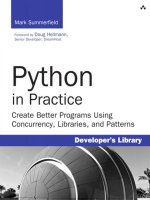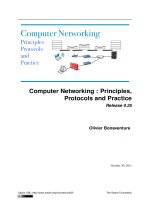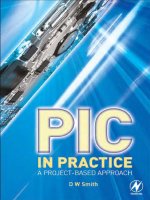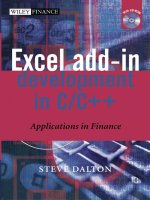iOS in Practice potx
Bạn đang xem bản rút gọn của tài liệu. Xem và tải ngay bản đầy đủ của tài liệu tại đây (14.18 MB, 305 trang )
Bear Cahill
Includes 98 Techniques
Covers iOS 6
MANNING
www.it-ebooks.info
iOS in Practice
www.it-ebooks.info
www.it-ebooks.info
iOS in Practice
BEAR CAHILL
MANNING
SHELTER ISLAND
www.it-ebooks.info
For online information and ordering of this and other Manning books, please visit
www.manning.com. The publisher offers discounts on this book when ordered in quantity.
For more information, please contact
Special Sales Department
Manning Publications Co.
20 Baldwin Road
PO Box 261
Shelter Island, NY 11964
Email:
©2013 by Manning Publications Co. All rights reserved.
No part of this publication may be reproduced, stored in a retrieval system, or transmitted, in
any form or by means electronic, mechanical, photocopying, or otherwise, without prior written
permission of the publisher.
Many of the designations used by manufacturers and sellers to distinguish their products are
claimed as trademarks. Where those designations appear in the book, and Manning
Publications was aware of a trademark claim, the designations have been printed in initial caps
or all caps.
Recognizing the importance of preserving what has been written, it is Manning’s policy to have
the books we publish printed on acid-free paper, and we exert our best efforts to that end.
Recognizing also our responsibility to conserve the resources of our planet, Manning books
are printed on paper that is at least 15 percent recycled and processed without the use of
elemental chlorine.
Manning Publications Co. Development editor: Scott Meyers
20 Baldwin Road Technical proofreader: James Hathewa
y
PO Box 261 Copyeditors: Linda Kern, Benjamin Berg
Shelter Island, NY 11964 Proofreaders: Katie Tennant, Alyson Brener
Typesetter: Dottie Marsico
Cover designer: Marija Tudor
ISBN 9781617291265
Printed in the United States of America
1 2 3 4 5 6 7 8 9 10 – MAL – 17 16 15 14 13 12
www.it-ebooks.info
To Kelly Ripa, who brightens my wife’s day,
who in turn brightens mine
www.it-ebooks.info
www.it-ebooks.info
vii
brief contents
PART 1 GETTING STARTED 1
1
■
Getting started with iOS development 3
2
■
Creating an iOS application 14
PART 2 PUTTING IOS INTO PRACTICE 21
3
■
Using view controllers and images in PicDecor 23
4
■
Accessing the address book/contacts in Dial4 60
5
■
MapKit and the camera in WhereIsMyCar 87
6
■
Settings, audio, and shake detection in TimeDown 114
7
■
CoreData, iPod access, and playing music—PlayMyLists 132
8
■
Push notification and in-app purchase—Rock, Paper,
Scissors 157
9
■
GameCenter leaderboards and achievements—Rock, Paper,
Scissors 184
10
■
iTunes API, iPad, and iAd—MusicSearch 206
11
■
Collection view, social, reminders, and state restoration—
MeetSocial 230
www.it-ebooks.info
www.it-ebooks.info
ix
contents
preface xv
acknowledgments xvi
about this book xvii
about the cover illustration xx
PART 1 GETTING STARTED 1
1
Getting started with iOS development 3
1.1 The iOS development environment 4
1.2 Using Xcode 4
Getting Xcode 5
■
Tour of Xcode 5
1.3 A quick Hello World app 8
Creating a New Project 8
■
Editing the user interface 10
1.4 Summary 13
2
Creating an iOS application 14
2.1 Source code files 15
2.2 Adding a button to your app 16
2.3 Connecting your button to an action 17
2.4 Connecting your label as an outlet 18
2.5 Implementing your button action 19
2.6 Delegation 20
2.7 Summary 20
www.it-ebooks.info
CONTENTSx
PART 2 PUTTING IOS INTO PRACTICE 21
3
Using view controllers and images in PicDecor 23
3.1 UI design concepts 24
Building blocks that can be customized 25
■
Product
definition statement 26
■
Thinking outside the box 26
Think Apple 27
3.2 Creating view controllers and other widgets 27
TECHNIQUE 1 Designing a view controller with IB 27
TECHNIQUE 2 Adding an ImageView and toolbar to a view 32
TECHNIQUE 3 Adding buttons to a view 36
3.3 Developing actions and outlets 37
TECHNIQUE 4 Declaring actions and outlets in Xcode 37
TECHNIQUE 5 Connecting actions and outlets to code 41
3.4 Using the camera/photo album 45
TECHNIQUE 6 Adding camera/photo album access 46
TECHNIQUE 7 Presenting a view controller modally 48
TECHNIQUE 8 Dismissing a modally displayed view controller 49
3.5 Displaying and handling images 50
Interact with the process as it goes 51
TECHNIQUE 9 Displaying selected images 51
TECHNIQUE 10 Detecting a device without a camera 53
3.6 Providing email capabilities 54
TECHNIQUE 11 Adding in-app email 54
TECHNIQUE 12 Scaling an image for email 57
TECHNIQUE 13 Using the activity indicator 57
3.7 Summary 58
4
Accessing the address book/contacts in Dial4 60
4.1 Creating a master-detail application with a table view 61
TECHNIQUE 14 Creating a master-detail application 61
4.2 Presenting data using a table view 63
TECHNIQUE 15 Displaying data in a table view 64
Apple cell styles 66
■
Cell customization 66
TECHNIQUE 16 Handling table view cell selection 67
4.3 Accessing the address book 68
TECHNIQUE 17 Retrieving the address book entries 69
TECHNIQUE 18 Obtaining address book image property 71
TECHNIQUE 19 Obtaining grouped properties from the address
book 72
www.it-ebooks.info
CONTENTS xi
TECHNIQUE 20 Making a call 74
TECHNIQUE 21 Displaying address book record details 76
4.4 Managing table data 80
TECHNIQUE 22 Deleting and rearranging table view rows 81
TECHNIQUE 23 Filtering displayed table view data 83
4.5 Summary 85
5
MapKit and the camera in WhereIsMyCar 87
5.1 Using maps with the user’s location 89
TECHNIQUE 24 Adding a MapView to a project 89
TECHNIQUE 25 Centering and zooming a MapView 91
TECHNIQUE 26 Finding the user’s location via CoreLocation 93
5.2 Displaying details on MapView locations
and storing user’s notes 94
TECHNIQUE 27 Displaying MapView pins 95
TECHNIQUE 28 Storing and retrieving the user’s location 98
TECHNIQUE 29 Reverse geocoding 100
TECHNIQUE 30 Adding pin callouts 101
TECHNIQUE 31 Typing and storing user’s note 104
5.3 Storing, retrieving, and displaying camera images 107
TECHNIQUE 32 Adding a camera control 108
TECHNIQUE 33 Receiving and storing the picture 110
TECHNIQUE 34 Displaying a picture 112
5.4 Summary 113
6
Settings, audio, and shake detection in TimeDown 114
6.1 Settings bundle in iOS projects 116
TECHNIQUE 35 Adding settings to an Xcode project 116
TECHNIQUE 36 Initializing iOS settings 118
TECHNIQUE 37 Accessing settings values in an app 119
TECHNIQUE 38 Setting the app settings icon 120
6.2 Runtime and time-based UI changes 122
TECHNIQUE 39 Rounding corners of a view 122
TECHNIQUE 40 Updating the UI with a repeating timer 124
6.3 Playing audio and vibrating the device 125
TECHNIQUE 41 Playing an MP3 file 126
TECHNIQUE 42 Vibrating the iPhone 127
6.4 Detecting and handling device motion 128
TECHNIQUE 43 Detecting shaking with the accelerometer 128
TECHNIQUE 44 Handling shaking with an action sheet 129
6.5 Summary 131
www.it-ebooks.info
CONTENTSxii
7
CoreData, iPod access, and playing music—PlayMyLists 132
7.1 Creating a table view project 133
TECHNIQUE 45 Create a project with table navigation 133
TECHNIQUE 46 Defining entities in CoreData 135
TECHNIQUE 47 Creating relationships in CoreData 137
TECHNIQUE 48 Inserting and deleting CoreData objects 139
TECHNIQUE 49 Creating classes for CoreData entities 141
7.2 Displaying CoreData for data-driven apps 143
TECHNIQUE 50 Display selected item details 143
TECHNIQUE 51 Passing a Playlist to the Detail View controller 144
TECHNIQUE 52 Replacing the detail view controller 146
TECHNIQUE 53 Managing tracks in the selected playlist 147
7.3 Accessing iPod music 148
TECHNIQUE 54 Using the media picker to access music 148
TECHNIQUE 55 Finding media info from the iPod 151
7.4 Playing music with iOS 152
TECHNIQUE 56 Playing the playlist 153
TECHNIQUE 57 Handling music player updates 154
7.5 Summary 156
8
Push notification and in-app purchase—Rock, Paper,
Scissors 157
8.1 Using Apple Push Notification 158
TECHNIQUE 58 Provisioning for push notification 158
TECHNIQUE 59 Configuring UrbanAirship for APN 161
TECHNIQUE 60 Registering your app for push notifications 164
TECHNIQUE 61 Registering your app with UrbanAirship 165
TECHNIQUE 62 Sending a batch push notification 167
8.2 In-app purchase 170
TECHNIQUE 63 Setting up iTunesConnect for in-app purchase 171
TECHNIQUE 64 Creating an in-app test account 174
TECHNIQUE 65 Adding in-app purchases to the project 175
8.3 The Rock, Paper, Scissors game 178
TECHNIQUE 66 Designing the game 178
TECHNIQUE 67 Overturning a loss 182
8.4 Summary 183
www.it-ebooks.info
CONTENTS xiii
9
GameCenter leaderboards and achievements—Rock, Paper,
Scissors 184
9.1 Game Center authentication and leaderboards 185
TECHNIQUE 68 Authenticating the player 185
TECHNIQUE 69 Configuring leaderboards in iTunesConnect 187
TECHNIQUE 70 Saving the player’s score 188
TECHNIQUE 71 Displaying the leaderboard 190
9.2 GameCenter achievements 192
TECHNIQUE 72 Adding an achievement in iTunesConnect 192
TECHNIQUE 73 Reporting achievement progress 193
TECHNIQUE 74 Displaying achievement boards 195
9.3 Matching and playing via GameCenter 196
TECHNIQUE 75 Matching players 196
TECHNIQUE 76 Inviting friends to play 200
TECHNIQUE 77 Voice chat via the GameCenter 204
9.4 Summary 205
10
iTunes API, iPad, and iAd—MusicSearch 206
10.1 Searching for music with the iTunes API 207
TECHNIQUE 78 Querying with the iTunes API 207
TECHNIQUE 79 Displaying JSON results 209
TECHNIQUE 80 Playing song preview 211
10.2 Converting an app to iPad 213
TECHNIQUE 81 Converting the project in Xcode 214
TECHNIQUE 82 Adding a split view to the app 218
TECHNIQUE 83 Displaying items in the detail view 224
10.3 Adding iAds to an app 226
TECHNIQUE 84 Configuring iTunes for iAds 226
TECHNIQUE 85 Adding iAds to an app 227
10.4 Summary 229
11
Collection view, social, reminders, and state restoration—
MeetSocial 230
11.1 Presenting data using a collection view 231
TECHNIQUE 86 Creating a project to use a collection view 231
TECHNIQUE 87 Fetching search results from Meetup.com 235
TECHNIQUE 88 Displaying items in a collection view 237
www.it-ebooks.info
CONTENTSxiv
11.2 Sharing via the Social Framework 242
TECHNIQUE 89 Specifying activity items 243
TECHNIQUE 90 Presenting the activity sharing interface 245
11.3 Creating calendar items in the OS 246
TECHNIQUE 91 Creating the event store and calendar event 246
TECHNIQUE 92 Creating a calendar reminder 250
11.4 Saving and restoring the UI state 252
TECHNIQUE 93 Specify that an app will save/restore 252
TECHNIQUE 94 Setting restoration IDs on objects 253
TECHNIQUE 95 Assigning restoration classes 254
TECHNIQUE 96 Encode/decode UI-related state values 255
TECHNIQUE 97 Table/collection datasource considerations 257
TECHNIQUE 98 Additional app version and state data 258
11.5 Summary 259
appendix The iOS developer program and app distribution 260
index 275
www.it-ebooks.info
xv
preface
My professional coding career has gone from large to small in a variety of ways. I
started on 3279 terminals at IBM, and with each professional move (from Ericsson to
Travelocity and others) I went to smaller machines and smaller companies. Now I
work on computers you can fit in your pocket and at a company of one: me.
When I first started working in mobile development, I used J2ME on various
phones, including Blackberries. When I got the chance to work on an iPhone, I pur-
chased my first MacBook and loved it! It wasn’t until sometime later that I realized that
I had gotten in at the beginning of the mobile wave. Solving problems alone, and often
under non-disclosure agreements, I learned a lot, and as each new version of the OS
came out, it got easier and better. The platform quickly became more sophisticated,
and so did the user.
Then Manning approached me to talk about a book on iOS development, and I
was surprised how clear and formed my opinions were about what should be included.
I had learned a lot on my own—from frameworks to widgets to the UI to MVC and
more—and I felt that emphasis was often placed on the wrong areas. I also felt that
the sample code provided by Apple was underemphasized. I believe that project-based
learning is the best—at least it is for me—and seeing how the different parts of a proj-
ect come together is not only useful but necessary to make sense of the project and
put it into context.
I was flattered that Manning asked me to write this book and I hope it will help you
to learn iOS development—and to put it into practice.
www.it-ebooks.info
xvi
acknowledgments
First I’d like to thank everyone at Manning, starting with my editors, Scott Meyers,
Troy Mott, and Jeff Bleiel, and then going on to publisher Marjan Bace and all the
others who helped along the way, including Nick Chase, Linda Kern, Benjamin Berg,
Katie Tennant, Alyson Brener, and Janet Vail, for their support and hard work.
I’d like to thank the following reviewers for reading my manuscript at various
stages of its development and providing invaluable feedback: Jonas Bandi, Jeremy
Villeneuve, Mekka Okereke, Amos Bannister, Stephen Aument, Bryan “Groucho”
Duke, Serban Porumbescu, Clint Tredway, Mike Stok, Arif Shaikh, Jonathan Hohle,
Gavin Whyte, Subhasis Ghosh, Mark Janssen, Barry Tolnas, and Christopher Haupt. I
would also like to thank James Hatheway for his technical review of the final manu-
script shortly before it went into production.
I’d also like to thank Eric Silverthorn, David Barnard, and Mekka Okereke for giv-
ing me so much help and work early on to get me started.
I’d like to thank Steve Jobs and everyone at Apple for creating this market and for
everything that surrounds what I get to do every day.
To O.A.R. and Seryn, thanks for providing the soundtrack to my writing of this
book and my coding in general.
Amy, my wife, deserves a lot of thanks for putting up with me during this time (and
all other times). Thanks to her and my sons for so much love.
And I thank God for all of the above—and everything else!
www.it-ebooks.info
xvii
about this book
This book is organized into two parts. Part one talks about iOS development in gen-
eral. How to get started, the frameworks provided by Apple, the Provisioning Portal,
the IDE, and several core concepts are introduced in this first part of the book. The
second part includes techniques for putting iOS development into practice. The chap-
ters in part 2 contain projects that are developed using multiple techniques. By the
end of the chapter (or two chapters in one case), you’ll go through the development
of an app from beginning to end.
The apps developed in the chapters can be found for free in the AppStore so you
can see how they wound up. But if you go through the chapters and follow along (or
download the source code), you will be able to see see how the app is coded and run
it yourself.
My suggestion is to follow along with the development of each project in each
chapter. Downloading the source code is helpful, but try typing out the lines of code
from the book, if you have time. This will help you to experience the process and you
will see how Xcode handles things like code-completion, navigation, UI design, and so
on. That hands-on experience is invaluable.
I expect you’re reading this book because you want to learn about different aspects
of iOS development and are just starting out. However, this is not an Objective-C pro-
gramming book. It’s assumed that you already know a bit of Objective-C, are learning
it concurrently, or are willing to glean what you can from diving right in. Regardless of
your level of experience, I recommend that you digest each line of code in order to
understand the details of all aspects of iOS development.
www.it-ebooks.info
ABOUT THIS BOOKxviii
Roadmap
Part 1 covers the groundwork needed to get started in iOS development. In chapter 1,
you’ll get to develop your first Hello World app, but we’ll also cover some of the core
areas and concepts of iOS development. Chapter 2 covers the development environ-
ment, including Xcode for editing the code and user interface along with other con-
cepts and tools.
Chapter 3 begins part 2 with your first real app project: PicDecor. In this chapter
you’ll learn about view controllers and displaying images as well as how to interface
with sending email. You’ll see how to design the UI, and how to connect it to the code
you’re writing.
Chapter 4 builds on what you learned in chapter 3 about view controllers by show-
ing you table view controllers and how to access the address book.
Chapter 5 continues with access to images through the photo album and the cam-
era and how to manipulate those images. Also, in chapter 5 you’ll see how to display a
map and the user’s location and store data for later retrieval and display.
The Settings Bundle is the official way to have a user manage app settings and is
covered in chapter 6. Also covered are playing MP3s and detecting motion (particu-
larly shaking) of the device. Chapter 7 goes further in playing audio, allowing the user
to make playlists and play them via the iPad framework. This includes covering Core-
Data for database design and for storing app data.
Push notifications and in-app purchase both use external server interaction for
their functionality and are covered in chapter 8 for our Rock, Paper, Scissors game.
Chapter 9 continues the game with GameCenter interaction including leaderboards
and achievements.
Chapter 10 could be called the “iChapter” as it covers using the iTunes
API to
search music, designing for the iPad, and advertising using iAds.
Finally, chapter 11 covers the more recent additions to iOS. Specifically, it covers
the collection view, Social Framework, reminders, and UI state restoration.
Code conventions
There are many Objective-C code examples in this book edited with Xcode. Source
code in listings and text is in a
fixed-width
font
like
this
to separate it from ordi-
nary text.
Writing code for a book is challenging compared with writing code that isn’t going
to be published for the world to see. Restrictions on line length, readability, and con-
ciseness encouraged decisions I might not have made otherwise. You will find that I
may have added a method to a class that might not make the most sense, or named
some variables in less-than-perfect ways. Please concentrate on the content over form
in those cases.
As all aspects of mobile, websites, documentation, tools, and so on change regu-
larly, some images in the book may not match what you see online and elsewhere.
However, the concepts are likely to remain, and the variance you might see shouldn’t
cause confusion.
www.it-ebooks.info
ABOUT THIS BOOK xix
Source code downloads
You will need a few things to benefit from the information presented in this book,
starting with an Apple computer. Then you will need to download Xcode and the
accompanying documentation, including public/open source libraries, as well as the
source code for the examples in the book. The chapters will then direct you on what
to do, one step at a time.
You will find the source code for the working examples in this book available for
download from the publisher’s website at www.manning.com/iOSinPractice.
You can also find some of the apps developed in this book in the Apple App Store.
About the title
The title of this book communicates its two core aspects—it covers iOS development
both in general and in practice. Learning happens best through examples and exer-
cises‚ as opposed to learning about theories or concepts in isolation. So I’ve included
numerous hands-on techniques and examples to get you started in iOS development.
About the author
Bear Cahill has worked in iOS development at Brainwash Inc. since 2008 and through
the development of several dozen apps. Prior to that, Bear worked at IBM, Ericsson,
and Travelocity, among other companies.
From REXX to BASIC to C++ to Java to Objective-C, along with several other lan-
guages, Bear has worked on a variety of platforms and technologies. He now focuses on
independent work, using friends to handle related server, Android, and other work.
Bear enjoys spending time with his wife and two sons around downtown Denton,
Texas. He has too many hobbies past and future to list here, so we’ll just say he’s never
been sky diving, scuba diving, or stage diving. No diving allowed!
Author Online
The purchase of iOS in Practice includes free access to a private forum run by Manning
Publications where you can make comments about the book, ask technical questions,
and receive help from the author and other users. You can access and subscribe to the
forum at www.manning.com/iOSinPractice. This page provides information on how
to get on the forum after you’re registered, what kind of help is available, and the
rules of conduct in the forum.
Manning’s commitment to our readers is to provide a venue where a meaningful
dialogue among individual readers and between readers and the author can take
place. It’s not a commitment to any specific amount of participation on the part of the
author, whose contribution to the book’s forum remains voluntary (and unpaid). We
suggest you try asking the author some challenging questions, lest his interest stray!
The Author Online forum and the archives of previous discussions will be accessi-
ble from the publisher’s website as long as the book is in print.
www.it-ebooks.info
xx
about the cover illustration
The figure on the cover of iOS in Practice is captioned “A man from Kastela, near Split,
Dalmatia, Croatia.” The illustration is taken from a reproduction of an album of tradi-
tional Croatian costumes from the mid-nineteenth century by Nikola Arsenovic, pub-
lished by the Ethnographic Museum in Split, Croatia, in 2003. The illustrations were
obtained from a helpful librarian at the Ethnographic Museum in Split, itself situated
in the Roman core of the medieval center of the town: the ruins of Emperor Diocle-
tian’s retirement palace from around AD 304. The book includes finely colored illus-
trations of figures from different regions of Croatia, accompanied by descriptions of
the costumes and of everyday life.
Kastela is a series of seven towns located on the Adriatic coast in central Dalmatia.
Once an ancient Greek port, a stopover point for the Roman army, and a summer place
for Croatian kings, Kastela today is a popular tourist resort. Along its long sandy beach
there are many terraces and lookout points, surrounded by pine and tamaris trees. The
figure on the cover is wearing black woolen trousers and a jacket over a white linen
shirt. His costume is richly trimmed with the colorful embroidery that is typical for this
region. He wears a red cap on his head and in his hand he holds a long pipe.
Dress codes and lifestyles have changed over the last 200 years, and the diversity by
region, so rich at the time, has faded away. It’s now hard to tell apart the inhabitants of
different continents, let alone of different hamlets or towns separated by only a few
miles. Perhaps we have traded cultural diversity for a more varied personal life—
certainly for a more varied and fast-paced technological life.
Manning celebrates the inventiveness and initiative of the computer business with
book covers based on the rich diversity of regional life of two centuries ago, brought
back to life by illustrations from old books and collections like this one.
www.it-ebooks.info
Part 1
Getting started
Before I cover the iOS apps created in each chapter, there’s some ground-
work to lay. Apple manages the AppStore and app development quite closely. I
believe this is for the protection of Apple, the developers‚ and the users. How-
ever, there’s a good bit of work and learning that needs to be done to get things
rolling. Early in chapter 1, you’ll get to develop your first Hello World app, but
I’ll also cover some of the core areas and concepts of iOS development.
Chapter 2 will cover more about the development environment‚ including
Xcode for editing the code and user interface‚ and other concepts and tools.
www.it-ebooks.info
www.it-ebooks.info
3
Getting started
with iOS development
I’ve been developing professionally for over 20 years in about every language and
platform, but I believe iOS development is some of the most exciting, fun, gratify-
ing, and challenging work I’ve ever done. I love iOS development.
Not only is it appealing from a developer’s standpoint, it’s also the leading
mobile platform. This means that there’s lots to do, with lots of growth and
changes, and plenty of support out there from Apple, forums, other developers,
books, conferences, and so on.
With the growth of iOS and other mobile platforms, tablets, which nicely bridge
traditional computers and smart phones, are now a huge market. These mobile
devices allow for more opportunities for development, and iOS lets you develop for
both platforms simultaneously.
This chapter covers
Xcode and Objective-C
Getting to know Xcode
A Hello World example
www.it-ebooks.info
4 CHAPTER 1 Getting started with iOS development
In this chapter, we develop an iOS application (or app). We need to go over a few
topics, including setting up the development environment, but by the end of the
chapter, you’ll have your first app. Let’s go!
1.1 The iOS development environment
Xcode is the primary tool for developing iOS (and OS X) applications. It’s free from
Apple and helps with a variety of development-related tasks including user interface
(UI) design/development, revision control, and more.
The primary language that iOS is developed in is called Objective-C. Objective-C is a
descendent of C, which means that all C code will compile and run in Objective-C.
But, unlike C, Objective-C is object-oriented. If you know C++, Java, or other object-
oriented languages, you’ll have no problem understanding this language. Keep in
mind that the purpose of this book isn’t to teach you Objective-C, so if you find you’re
having a hard time with the language, you may want to take some time and use other
resources to research Objective-C.
Apple also provides a rich set of frameworks. Some are required for any app and
are automatically included. The rest are optional‚ depending on your preferences‚
and can greatly add to your project. When iOS first came out, displaying a map of a
location was difficult and labor intensive. Adding pinned locations to the map was
even more complex. When MapKit was introduced, adding a map and displaying the
user’s location became practically effortless.
WebKit, StoreKit, MediaPlayer, Social, and CoreData are a few more frameworks
that bring ease of functionality when added to your projects. Many open source and/
or third-party frameworks are available to keep you from having to reinvent the wheel
for common—but complicated—functionality.
iOS development also relies heavily on the Model-View-Controller (MVC) architecture
pattern. MVC is the separation of your development into three aspects: model, view,
and controller. The model is the data layer (for example, the database in a project). The
view is the UI that the user interacts with. The controller is between the view and the
model, and it translates the user interaction to logic and accesses data as necessary.
As you can see, Xcode does a lot to facilitate what you need to do as a developer as
well as enables you to do it in a fashion best suited for iOS projects. Let’s look into the
details of getting, installing, and becoming familiar with Xcode, and then you’ll
develop your first app.
1.2 Using Xcode
As stated in the previous section, Xcode is the primary development tool for iOS proj-
ects. In this section, we look at how to get Xcode from Apple and tour the various
parts of Xcode to simplify iOS development.
www.it-ebooks.info









